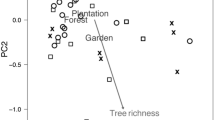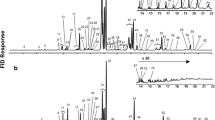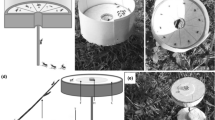Abstract
Stingless bees (Apidae: Meliponini) are the most diverse group of Apid bees and represent common pollinators in tropical ecosystems. Like honeybees they live in large eusocial colonies and rely on complex chemical recognition and communication systems. In contrast to honeybees, their ecology and especially their chemical ecology have received only little attention, particularly in the Old World. We previously have analyzed the chemical profiles of six paleotropical stingless bee species from Borneo and revealed the presence of species-specific cuticular terpenes— an environmentally derived compound class so far unique among social insects. Here, we compared the bees’ surface profiles to the chemistry of their nest material. Terpenes, alkanes, and alkenes were the dominant compound groups on both body surfaces and nest material. However, bee profiles and nests strongly differed in their chemical composition. Body surfaces thus did not merely mirror nests, rendering a passive compound transfer from nests to bees unlikely. The difference between nests and bees was particularly pronounced when all resin-derived compounds (terpenes) were excluded and only genetically determined compounds were considered. When terpenes were included, bee profiles and nest material still differed, because whole groups of terpenes (e.g., sesquiterpenes) were found in nest material of some species, but missing in their chemical profile, indicating that bees are able to influence the terpene composition both in their nests and on their surfaces.



Similar content being viewed by others
References
Abdalla, F. C., Jones, G. R., Morgan, E. D., and Da Cruz-Landim, C. 2003. Comparative study of the cuticular hydrocarbon composition of Melipona bicolor Lepeletier, 1836 (Hymenoptera, Meliponini) workers and queens. Genet. Molec. Res. 2:191–199.
Ayasse, M., Engels, W., Lübke, G., Taghizadeh, T., and Francke, W. 1999. Mating expenditures reduced via female sex pheromone modulation in the primitively eusocial halictine bee, Lasioglossum (Evylaeus) malachurum (Hymenoptera : Halictidae). Behav. Ecol. Sociobiol. 45:95–106.
Blomquist, G. J., Chu, A. J., and Remaley, S. 1980. Biosynthesis of wax in the honeybee, Apis mellifera L. Insect Biochem. 10:313–321.
Blomquist, G. J., Roubik, D. W., and Buchmann, S. L. 1985. Wax chemistry of 2 stingless bees of the Trigonisca group (Apididae, Meliponinae). Comp. Biochem. Physiol. B-Biochem. Mol. Biol. 82:137–142.
Blum, M. S., Kerr, W. E., and Fales, H. M. 1970. The chemical basis of insect sociality. pp. 61–94, in M. Beroza (ed.). Chemicals Controlling Insect Behavior. Academic Press, New York.
Breed, M. D., Garry, M. F., Pearce, A. N., Hibbard, B. E., Bjostad, L. B., and Page, R. E. 1995. The role of wax comb in honeybee nestmate recognition. Anim. Behav. 50:489–496.
Breed, M. D., Leger, E. A., Pearce, A. N., and Wang, Y. J. 1998. Comb wax effects on the ontogeny of honey bee nestmate recognition. Anim. Behav. 55:13–20.
Breed, M. D., Perry, S., and Bjostad, L. B. 2004. Testing the blank slate hypothesis: why honeybee colonies accept young bees. Insect. Soc. 51:12–16.
Buckner, J. L. 1993. Cuticular polar lipids in insects. pp. 227–270, in D. W. Stanley-Samuelson, D. R. Nelson (ed.). Insect Lipids: Chemistry, Biochemistry and Biology. University of Nebraska Press, Lincoln, Nebraska.
Dworschak, K., and Blüthgen, N. 2010. Networks and dominance hierarchies: does interspecific aggression explain flower partitioning among stingless bees? Ecological Entomol. 35: 216–225.
Eltz, T. 2004. Spatio-temporal variation of apine bee attraction to honeybaits in Bornean forests. J. Trop. Ecol. 20:317–324.
Endler, A., Liebig, J., Schmitt, T., Parker, J. E., Jones, G. R., Schreier, P., and Holldobler, B. 2004. Surface hydrocarbons of queen eggs regulate worker reproduction in a social insect. Proc. Natl. Acad. Sci. U. S. A. 101:2945–2950.
Espelie, K. E., Gamboa, G. J., Grudzien, T. A., and Bura, E. A. 1994. Cuticular hydrocarbons of the paper wasp, Polistes fuscatus— a search for recognition pheromones. J. Chem. Ecol. 20:1677–1687.
Fox, J. D. 1973. A Handbook to Kabili-Sepilok Forest Reserve. S. F. Department, editor. Sandakan, Malaysia.
Francis, B. R., Blanton, W. E., Littlefield, J. L., and Nunamaker, R. A. 1989. Hydrocarbons of the cuticle and hemolymph of the adult honey bee (Hymenoptera, Apidae). Ann. Entomol. Soc. 82:486–494.
Francis, B. R., Blanton, W. E., and Nunamaker, R. A. 1985. Extractable surface hydrocarbons of workers and drones of the genus Apis. J. Apic. Res. 24:13–26.
Fröhlich, B., Riederer, M., and Tautz, J. 2000a. Comb-wax discrimination by honeybees tested with the proboscis extension reflex. J. Exp. Biol. 203:1581–1587.
Fröhlich, B., Tautz, J., and Riederer, M. 2000b. Chemometric classification of comb and cuticular waxes of the honeybee Apis mellifera carnica. J. Chem. Ecol. 26:123–137.
Hepburn, R., Duangphakdee, O., Phiancharoen, M., and Radloff, S. 2010. Comb wax salvage by the red dwarf honeybee, Apis florea F. J. Insect Behav. 23:159–164.
Hölldobler, B. 1995. The chemistry of social regulation— multicomponent signals in ant societies. Proc. Natl. Acad. Sci. U. S. A. 92:19–22.
Howard, R. W., Mcdaniel, C. A., Nelson, D. R., Blomquist, G. J., Gelbaum, L. T., and Zalkow, L. H. 1982. Cuticular hydrocarbons of Reticulitermes virginicus (Banks)1 and their role as potential species- and caste-recognition cues. J. Chem. Ecol. 8:1227–1239.
Jungnickel, H., Da Costa, A. J. S., Tentschert, J., Patricio, E., Imperatriz-fonseca, V. L., Drijfhout, F., and Morgan, E. D. 2004. Chemical basis for inter-colonial aggression in the stingless bee Scaptotrigona bipunctata (Hymenoptera : Apidae). J. Insect Physiol. 50:761–766.
Kaib, M., Jmhasly, P., Wilfert, L., Durka, W., Franke, S., Francke, W., Leuthold, R. H., and Brandl, R. 2004. Cuticular hydrocarbons and aggression in the termite Macrotermes subhyalinus. J. Chem. Ecol. 30:365–385.
Kerr, W. E., Jungnickel, H., and Morgan, E. D. 2004. Workers of the stingless bee Melipona scutellaris are more similar to males than to queens in their cuticular compounds. Apidologie 35:611–618.
Leonhardt, S. D., and Blüthgen, N. 2009. A sticky affair: resin collection by Bornean stingless bees. Biotropica 41:730–736.
Leonhardt, S. D., Blüthgen, N., and Schmitt, T. 2009. Smelling like resin: terpenoids account for species-specific cuticular profiles in Southeast-Asian stingless bees. Insect. Soc. 56:157–170.
Leonhardt, S. D., Jung, L. M., Schmitt, T., and Blüthgen, N. 2010a. Terpenoids tame aggressor: role of chemicals in stingless bee communal nesting. Behav. Ecol. Sociobiol. 64: 1415–1423.
Leonhardt, S. D., Zeilhofer, S., Blüthgen, N., and Schmitt, T. 2010b. Stingless bees use terpenes as olfactory cues to find resin sources. Chem. Senses: doi:10.1093/chemse/bjq058 .
Lockey, K. H. 1988. Lipids of the insect cuticle: origin, composition and function. Comp. Biochem. Physiol. B-Biochem. Mol. Biol. 89B:595–645.
Mant, J., Brändli, C., Vereecken, N. J., Schulz, C. M., Francke, W., and Schiestl, F. P. 2005. Cuticular hydrocarbons as sex pheromone of the bee Colletes cunicularius and the key to its mimicry by the sexually deceptive orchid, Ophrys exaltata. J. Chem. Ecol. 31:1765–1787.
Marsh, C. W., and Greer, A. G. 1992. Forest land-use in Sabah, Malaysia: an introduction to Danum Valley. Philosoph. Trans. R. Soc. Lond. B 335:331–339.
Milborrow, B. V., Kennedy, J. M., and Dollin, A. 1987. Composition of Wax Made by the Australian Stingless Bee Trigona-Australis. Austr. J. Biol. Sci. 40:15–25.
Moure, J. S. 1961. A preliminary supra-specific classification of the old world meliponine bees (Hymenoptera, Apoidea) Studia Entomologica 4:181–242.
Nunes, T. M., Nascimento, F. S., Turatti, I. C., Lopes, N. P., and Zucchi, R. 2008. Nestmate recognition in a stingless bee: does the similarity of chemical cues determine guard acceptance? Anim. Behav. 75:1165–1171.
Nunes, T. M., Turatti, I. C. C., Mateus, S., Nascimento, F. S., Lopes, N. P.,and Zucchi, R. 2009. Cuticular hydrocarbons in the stingless bee Schwarziana quadripunctata (Hymenoptera, Apidae, Meliponini): differences between colonies, castes and age. Genet. Molec. Res. 8:589–595.
Paulmier, I., Bagnères, A. G., Afonso, C. M. M., Dusticier, G., Riviere, G., and Clément, J. L. 1999. Alkenes as a sexual pheromone in the alfalfa leaf-cutter bee Megachile rotundata. J. Chem. Ecol. 25:471–490.
Roubik, D. W. 1989. Ecology and Natural History of Tropical Bees. Cambridge University Press, New York.
Roubik, D.W. 2006. Stingless bee nesting biology. Apidologie 37: 124–143.
Sramkova, A., Schulz, C., Twele, R., Francke, W., and Ayasse, M. 2008. Fertility signals in the bumblebee Bombus terrestris (Hymenoptera : Apidae). Naturwissenschaften 95:515–522.
St. Leger, R. J. 1995. Integument as a barrier to microbial infections. pp. 284–306, in: K. Binnington, I. Retnakaran (ed.). Physiology of the Insect Epidermis. CSIRO Publications, Melbourne.
Acknowledgements
We are grateful to the Economic Planning Unit (EPU) for giving us permission to perform research in Malaysia, and the Royal Society for their help with planning and conducting field work in Borneo. Dr. Chey Vun Khen and Dr. Arthur Chung (Forestry Research Centre, Sandakan) kindly supported this project. The comments of two anonymous reviewers greatly improved the manuscript. SDL was supported by a grant of the German Excellence Initiative to the Graduate School of Life Science, University of Würzburg, and NB and TS by the Sonderforschungsbereich SFB 554 (Mechanisms and Evolution of Arthropod Behaviour) of the Deutsche Forschungsgemeinschaft (DFG).
Author information
Authors and Affiliations
Corresponding author
Rights and permissions
About this article
Cite this article
Leonhardt, S.D., Blüthgen, N. & Schmitt, T. Chemical Profiles of Body Surfaces and Nests from Six Bornean Stingless Bee Species. J Chem Ecol 37, 98–104 (2011). https://doi.org/10.1007/s10886-010-9900-5
Received:
Revised:
Accepted:
Published:
Issue Date:
DOI: https://doi.org/10.1007/s10886-010-9900-5




